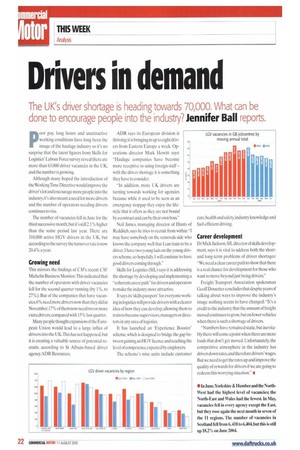Drivers in demand
Page 22

If you've noticed an error in this article please click here to report it so we can fix it.
The UK's driver shortage is heading towards 70,000. What can be done to encourage people into the industry? Jennifer Ball reports.
poor pay, long hours and unattractive working conditions have long been the image of the haulage industry so it's no surprise that the latest figures from Skills for Logistics' Labour Force survey reveal there are more than 63,000 driver vacancies in the UK, and the number is growing, Although many hoped the introduction of the Working Time Directive would improve the driver's lot and encourage more people into the industry, it's also meant a need for more drivers and the number of operators needing drivers continues to rise.
The number of vacancies fell in June for the third successive month, but it's still 2.1% higher than the same period last year. There are 310,000 active HGV drivers in the UK, but according to the survey the turnover rate is now 20,4% a year.
Growing need This mirrors the findings of CM's recent CM/ Michelin Business Monitor.This indicated that the number of operators with driver vacancies fell for the second quarter running (by 1%, to 27%). But of the companies that have vacancies, 6% need more drivers now than they did in November; 17% of them now need two or more extra drivers, compared with 15% last quarter.
Many people thought expansion of the European Union would lead to a large influx of drivers into the UK,This has not happened, but it is creating a valuable source of potential recruits, according to St Albans-based driver agency ADR Resources. ADR says its European division is thriving; it is bringing in up to eight drivers from Eastern Europe a week. Operations director Mark Howitt says: "Haulage companies have become more receptive to using foreign staff— with the driver shortage it is something they have to consider.
"In addition. more UK drivers are turning towards working for agencies because while it used to be seen as an emergency stopgap they enjoy the lifestyle that it offers as they are not bound by a contract and can be their own boss."
Neil James, managing director of Hunts of Redditch. says he tries to recruit from within: "I may have somebody on the removals side who knows the company well that I can train to be a driver.1 have two young lads on the young drivers scheme, so hopefully I will continue to have good drivers coming through."
Skills for Logistics (SfL) says it is addressing the shortage by developing and implementing a "coherent career path" for drivers and operators to make the industry more attractive.
It says its 'skills passport' for everyone working in logistics will provide drivers with a clearer idea of how they can develop, allowing them to train to become supervisors, managers or directors in any area of logistics.
It has launched an 'Experience Booster' scheme, which is designed to bridge the gap between gaining an FIGV licence and reaching the level of competence expected by employers.
The scheme's nine units include customer care, health and safety, industry knowledge and fuel-efficient driving.
Career development
Dr Mick Jackson,S1L director of skills development, says it is vital to address both the shortand long-term problems of driver shortages: "We need a clear career path to show that there is a real chance for development for those who want to move beyond just being drivers."
Freight Transport Association spokesman Geoff Dossetter concludes that despite years of talking about ways to improve the industry's image nothing seems to have changed: "It's a credit to the industry that the amount of freight moved continues to grow, but onfewer vehicles when there is such a shortage of drivers.
"Numbers have remained static, but inevitably there will come a point when there are more loads that don't get moved. Unfortunately, the competitive atmosphere in the industry has driven down rates, and therefore drivers' wages But we need to get the rates up and improve the quality of rewards for drivers if we are going to redeem this worrying situation.• • In June,Yorkshire & Humber and the NorthWest had the highest level of vacancies; the North-East and Wales had the fewest. In May, vacancies fell in every agency except the East, but they rose again the next month in seven of the 11 regions. The number of vacancies in Scotland fell from 6,418 to 6,404, but this is still up 18.2% on June 2004.


































































































































































































